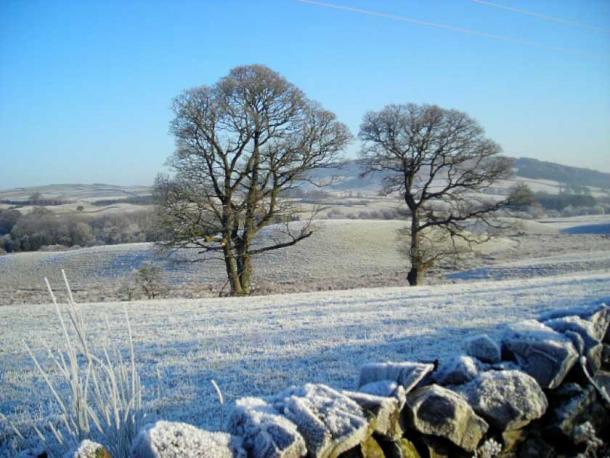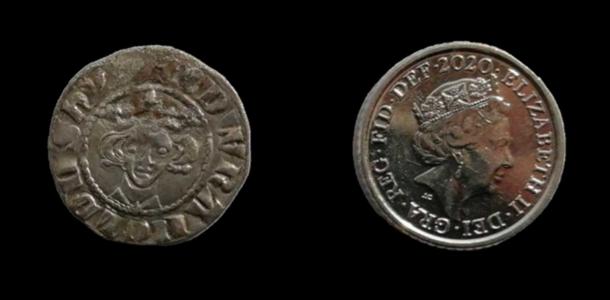
Scottish Detectorists Swoop Over 8,000 Medieval Coins
Metal detectorists in Scotland have unearthed thousands of 13th and 14th century coins. Dubbed the Dunscore hoard, this amazing find is the largest hoard of medieval coins to have been discovered in Scotland in the last two centuries.

The countryside surrounding Dunscore, a Scottish village where the hoard of medieval coins was discovered. (Iain Thompson / CC BY-SA 2.0)
Someone’s Going to Get Rich, But Not Anytime Soon
The hoard of medieval coins was discovered near the idyllic Scottish village of Dunscore, near the town of Dumfries on the southwest coast of Scotland. Comprising Scottish, Irish, English and continental silver coins, the Scottish Daily Record reported that the majority of the 8,407 coins are Edward I and II pennies.
The English King Edward I, also known as the Hammer of the Scots due to his military campaigns against Scotland, was succeeded by Edward II and Edward III. As a result, all English pennies from the time of their reigns bore the name Edward, and their basic design was the same.
- Medieval Coin in Canada Challenges Story of North American Discovery
- Polish Dog Unearths Rare Booty of Revealing Bracteate Medieval Coins
According to an article on UK Detector Finds Database (UKDFD) the recoinage that commenced during the seventh year of Edward I's reign established a format for the design of English coins that was to last for over two hundred years. This means the job of identifying the individual coins will be exceptionally complicated and will take a long time.
Prior to the completion of any formal analysis, however, the Scottish Treasure Trove Unit who deals with all public finds of historic artifacts and treasure hoards confirmed that this is one of “the largest medieval coin hoards found in Scotland since the 19th century.” As such, the haul is estimated to be worth “hundreds of thousands of pounds.”

A 1279 to 1305 Edward I penny next to a 2020 Elizabeth II 5 pence coin. The medieval coins unearthed by metal detectorists include pennies like this one. (Tim O’Doherty / CC BY-SA 4.0)
Hoard of Medieval Coins Called “Absolutely Amazing Find”
When the metal detectorists reported their finding of the medieval coins, the location was quickly excavated by a team of archaeologists from the Scottish Treasure Trove Unit along with National Museums Scotland archaeologists. Colin Mitchell of Dunscore Heritage Centre told the Daily Record that the coins are an “absolutely amazing find,” adding that at this stage the medieval coins technically belong to the Crown.
Ken McNab, Senior Communications Officer at Crown Office and Procurator Fiscal Service told Artnet News that the Dunscore hoard is still being catalogued. But after every one of the medieval coins has been weighed, measured and photographed the Scottish Archaeological Finds Allocation Panel will advise the King’s and Lord Treasurer’s Remembrancer if the Crown should exercise its claim over the hoard, or not.
At such times that the Crown does exercise its claim over the medieval coins, the discovery will become a registered national treasure. If that happens, an ex gratia award (meaning a finder’s fee) will be awarded to the metal detectorists and the landowner.
A huge haul of 8,407 medieval silver coins has been unearthed by metal detectorists in what is believed to be the single biggest hoard of ancient treasure ever found in Scotland - labelled the Dunscore Hoard after the Dumfriesshire village.https://t.co/sA9fg3YzXj
— Bob Glen (@bobglen1) November 20, 2022
There’s Gold in Them Thar Hills
While the phrase “there’s gold in them thar hills” was made famous by Yosemite Sam in the Looney Tunes cartoons, it nevertheless applies directly to Dumfries and Galloway in Scotland. In 2014, Derek McLennan, a retired businessman, was metal detecting in Dumfries and Galloway when he discovered one of “the most significant collections of Viking Age objects ever found in Britain.”
Ancient Origins reported at the time that this hoard of over 100 artifacts dating from around 900 AD included “a magnificent solid silver cross.” In this instance the finder received a cool £2 million (US$2.6m) reward from the Crown.
- Illegal Metal Detectorists Cause Irreparable Damage to 1900-Year-Old Hadrian’s Wall
- Nighthawkers are Robbing England of its Past
The Scottish Treasure Trove recently concluded a survey of Scotland's metal detectorists and estimated that there were around 520 “active” hobbyists plying their craft at least once a month. As such, MENAFN reported that the 1,500 artifacts unearthed in 2019 have amplified to “12,263 artifacts having been found so far in 2022.”
According to a dissertation from the University of Edinburgh, this sharp increase in the number of finds made by Scottish metal detectorists has caused “unprecedented challenges” to the already struggling Treasure Trove Unit.
With all of these ancient and highly-valuable artifacts being uncovered in Dumfries and Galloway, Colin Mitchell from the Dunscore Heritage Centre would agree that the Treasure Trove Unit is about to get a lot busier. According to Mitchel, treasure hunters “are aware of many ancient local sites nearby.” Besides the amazing Dunscore hoard, the question now remains as to what other fascinating finds have yet to be unearthed in the area.
Top image: Metal detectorists have unearthed a hoard of medieval coins, like this Edward I penny. Source: Public domain
By Ashley Cowie















